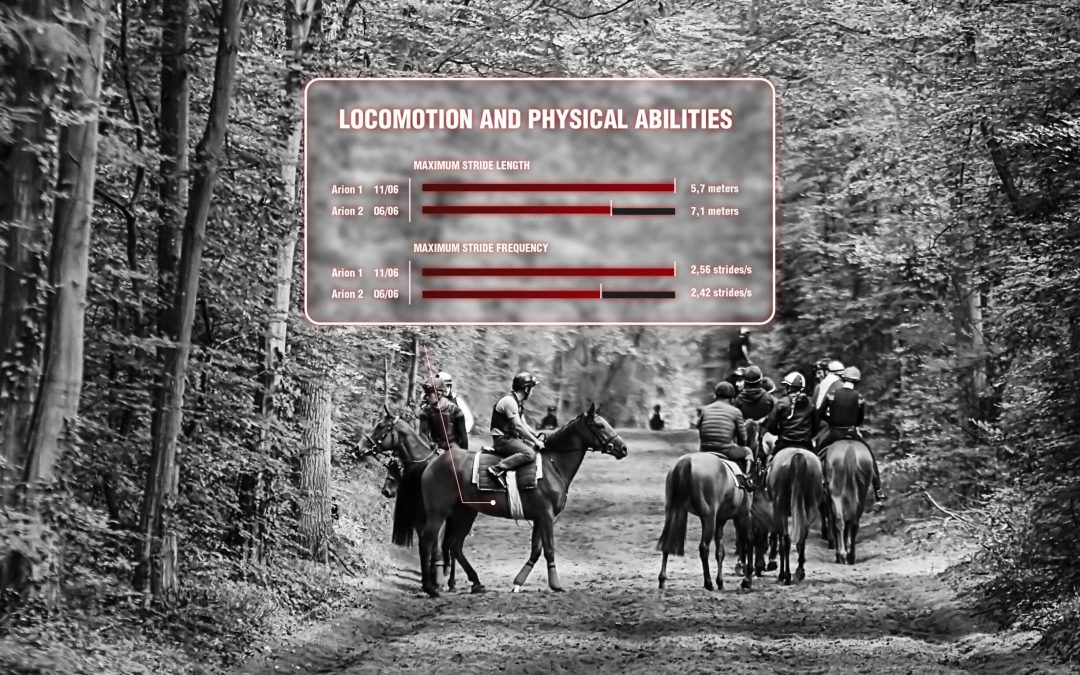The racehorse’s speed aptitudes seem to be the most important factor in his success. Each one has his specific stride, which defines his speed aptitudes. To increase his speed, the horse increases his stride frequency and stride length. Does stride length change in the same way as stride frequency? How do horses adapt their stride length and stride frequency to a given speed?
1. Locomotion at the origin of the racehorse’s speed aptitudes
A horse’s pace increases linearly with speed until he reaches a maximum speed. The stride frequency can vary in the same way from 25 to 30km/h as it does from 55 to 60km/h.
On the contrary, stride length does not evolve linearly. Its evolution depends on the speed and it will be more important for low speeds than higher speeds. At high speed, a variation in stride frequency will produce greater acceleration.
The graphs showing the stride frequency and stride length as a function of speed are specific to each horse. Each curve describes how the horse accelerates and how the frequency and length of the strides change. Each horse is unique, and his locomotor profile is a valuable help to discover his potential or decide how far to race him.
We compared two horses monitored with Equimetre. These two horses have very different locomotor profiles. We can see that Arion I trains at a very fast stride frequency while Arion II trains at a very wide stride length.
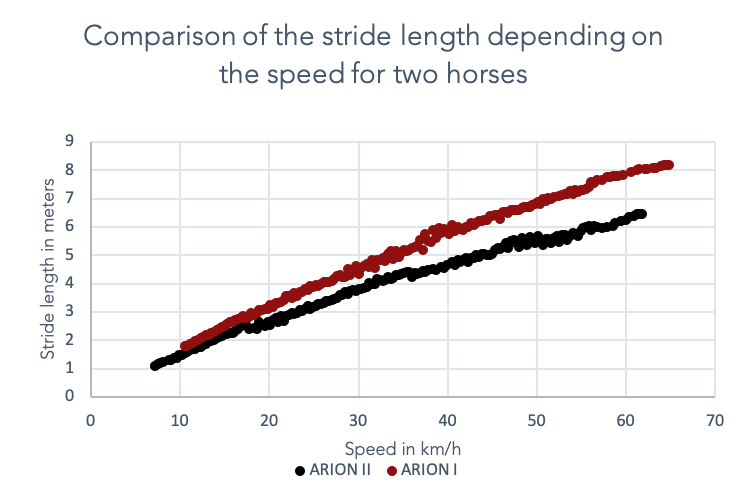
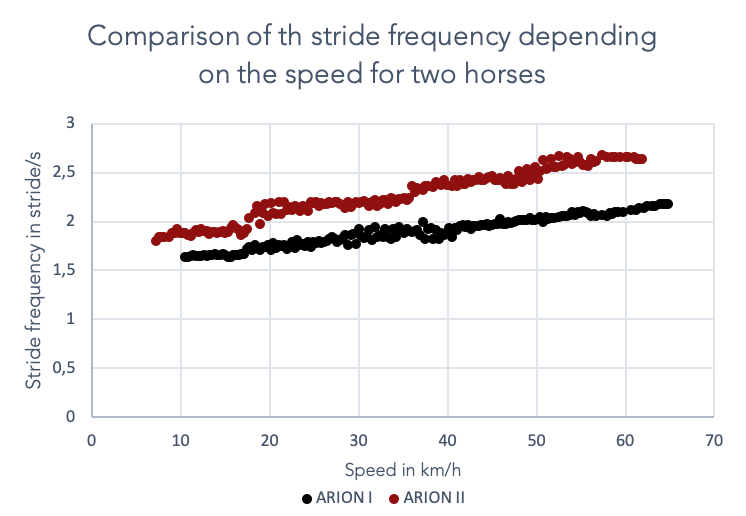
These graphs show the stride length and stride frequency curves as a function of speed for two horses: ARION I and ARION II.
2. Acceleration strategies and locomotion
During a race, horses are exposed to many changes of rhythm. These changes are influenced by the track, the race pace or the will of the jockey. This leads the horses to constantly adapt their locomotion. They must be able to accelerate or slow down according to the circumstances. These changes should be quick and consume little energy.
The following graph (HIRAGA, YAMANOBE and KUBO, 1994) shows the evolution of stride frequency and stride length for the first 30 strides at the start of a race. If the stride frequency reaches its nominal value from the beginning, the acceleration is made thanks to the progressive increase of the stride length during the first 20 strides before stabilizing.
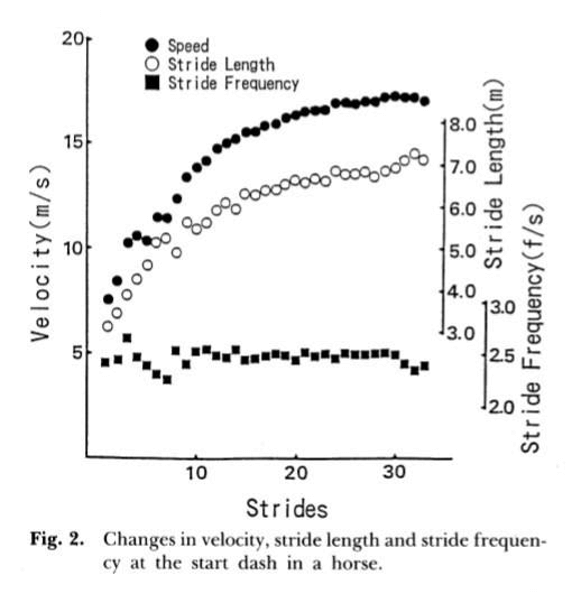
Fun fact
When the rider stimulates the horse with a whip, there is a reduction in the length of the strides and an increase in their frequency. However, speed is not significantly influenced. The use of the whip affects the horse’s locomotor strategy rather than speed (Deuel and Lawrence, 1988)!
By studying the training data on several horses, we can see that depending on their rhythm, the pace and stride length do not vary in the same way. During the deceleration, the stride frequency tends to be lower for the same speed than during the acceleration.
When the speed changes during a race, horses spontaneously adopt the stride frequency-stride length pair they prefer. As two horses can progress at the same speed with different stride frequency and stride length, a horse may prefer a wide stride length but with a longer stride time (slower stride frequency) or, on the contrary, a very fast stride but not very wide. By comparing a horse with the average at a given speed, it is possible to determine if the horse prefers to race in stride frequency: he makes faster strides than the average, or in stride length: his strides are larger than normal.
By studying the training data of several horses, we can see that depending on their rhythm, the pace and stride length do not vary in the same way. During deceleration, the stride frequency tends to be lower for the same speed than during acceleration. Regarding the stride length, the contrary happens : it is higher during deceleration.
In this example, Arion II is galloping at s=5.65 × 2.54=14.3 m/s (or 51.5 km/h) while Arion III is also galloping at s=6.1 × 2.36=14.3 m/s. Nevertheless these two horses have completely different strategies: Arion II favors stride frequency and Arion III stride length.
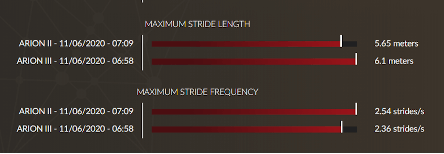
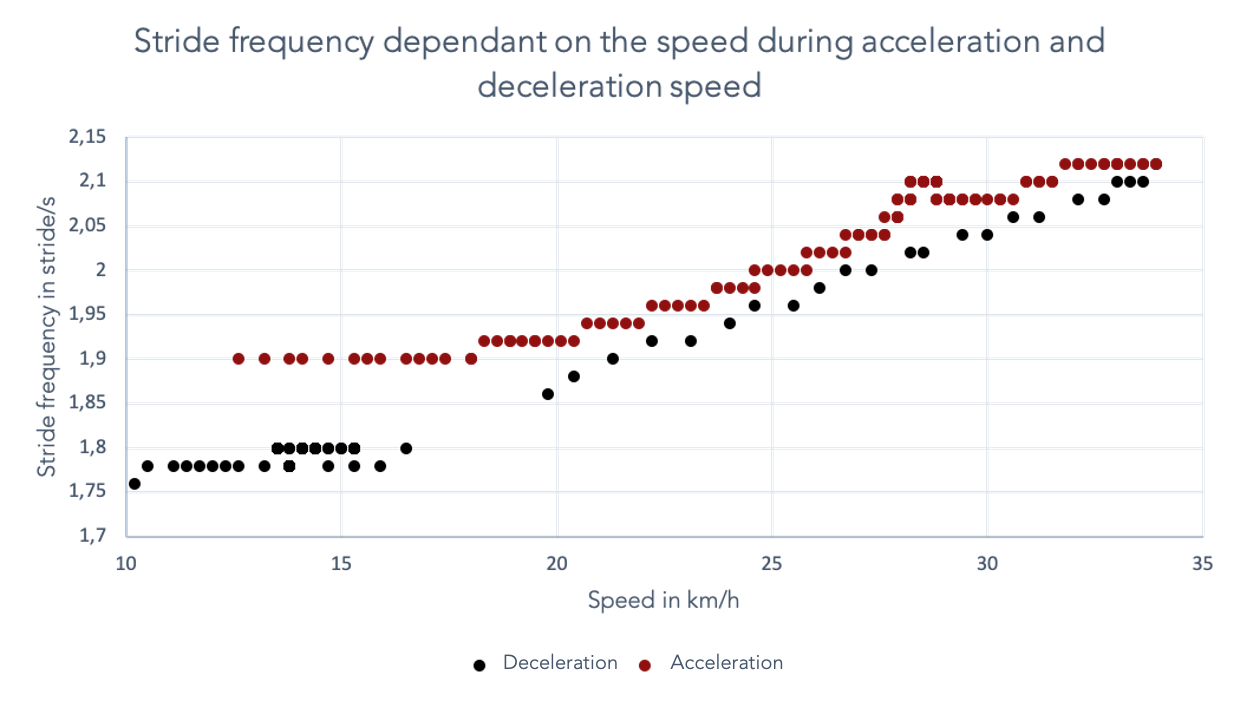
In order to give trainers a few reference points, here is the stride length and average stride frequency calculated during the race over 200m sections run by gallopers at an average of 70, 65, 60, 55 and 50km/h.
This table regroups the same data as the previous one but for harness trotting races with averages of 1’10, 1’15, 1’20, 1’25, 1’30 min/km.


3. Racehorse’s speed aptitudes: how to detect future performers thanks to locomotion data?
It may seem obvious that the more a horse has a great stride length and a great stride frequency, the faster he is. However, this is not always true. Indeed, horses having a very high-speed peak do not always win. The jockey must choose a strategy that matches the horse’s locomotor profile.
What is a good stride? What is the reference among great champions? How to get the most out of a horse according to his locomotor profile?
Scientists have managed to bring to light common points specific to horses with optimal stride efficiency. Among them :
- Low contact time with the ground
- Little upward bounce
- A great distance covered during the flight time
To these are added for gallopers :
- A greater dissociation of the diagonal
- A reduction in the time where two members touch the ground together
The idea that a good horse necessarily has a wide stride is a myth. Altough Secretariat or Black Caviar had a stride length of 8m20 and 8m50 respectively, Winx’s stride length was only measured at 6m80. However, her stride frequency was quite remarquable: she could perform up to 2.8 strides per second! On specific distances, a very high pace is a real asset. Smaller differences can be found in trotters. Bold Eagle has an amplitude of 6m40. However, he can performs up to 2.8 or 2.9 strides per second! Timoko relies more on his stride length exceeding 6m70 than on his stride frequency of 2.5 strides per second.
Depending on the locomotor profile of each horse, the entry distance and the race strategy differ. A horse with a great stride length should start the sprint from a distance to allow him to reach his maximum speed by giving him time to increase the size of his strides to their maximum. On the contrary, a horse with a fast stride frequency should wait until the last moment because the maximum speed will be reached quickly. A sprint starting from a far distance may exhaust the horse, who would no longer be able to maintain his pace during the last few meters. To sum up, a wide stride length is not “better” than a fast stride frequency. It is rather a question of making the best use of the strengths of each horse.
To conclude, each horse increases his stride lengths and stride frequency differently according to the desired speed. This evolution reflects the locomotor profile. Horses adapt their locomotion to a new speed by first changing their stride frequency. Whether a horse prefers to train in stride length or stride frequency is of little importance as long as the engagements and racing strategies are adapted.
Bibliography
HIRAGA, A., YAMANOBE, A. and KUBO, K., 1994. Relationships between Stride Length, Stride Frequency, Step Length and Velocity at the Start Dash in a Racehorse. Journal of Equine Science, 5(4), pp.127-130.
Key words : Racehorse’s speed aptitudes, racehorse cadence, racehorse amplitude, locomotor profil, acceleration strategy, cadence-amplitude ratio, racehorse maximal speed, future performer

